Unlock the full potential of your fat loss journey by understanding the pros and cons of cardio, and why incorporating weight training can be a game-changer for your overall fitness.
Cardiovascular exercise, commonly referred to as "cardio," is indeed a great way to burn fat and improve overall health. However, it's important to understand both its benefits and limitations in the context of fat loss. Additionally, incorporating weight training can be beneficial to amplify fat loss. Let's explore these aspects in more detail:
Benefits of Cardio for Fat Loss:
Calorie Burn: Cardio exercises like running, cycling, swimming, or brisk walking elevate your heart rate and increase your body's energy expenditure. This helps you burn calories, and as a result, fat, when performed consistently and at the appropriate intensity.
Improved Metabolism: Regular cardio can boost your metabolic rate, even after the workout is finished, through a phenomenon known as the "afterburn" or excess post-exercise oxygen consumption (EPOC). This means you continue to burn calories post-workout, aiding in fat loss.
Heart Health :Cardiovascular exercises strengthen your heart and improve overall cardiovascular health. This leads to better circulation and potentially more efficient fat utilization.
Stress Reduction: Cardio can help reduce stress, which is important because stress can contribute to weight gain and fat retention in some individuals.
Drawbacks of Relying Solely on Cardio for Fat Loss:
Muscle Loss: Excessive cardio, especially when combined with a low-calorie diet, can lead to muscle loss along with fat loss. This can result in a less toned appearance.
Plateau: Over time, your body may adapt to cardio, and your progress can plateau. You may burn fewer calories during the same workouts, making it harder to continue losing fat.
Time-Consuming: Cardio workouts can be time-consuming, requiring longer durations to burn a significant number of calories compared to other forms of exercise.
Why You Should Incorporate Weight Training:
Adding weight training to your fitness routine can complement the benefits of cardio and amplify fat loss in several ways:
Muscle Preservation: Weight training helps preserve and build lean muscle mass. This is crucial because muscle tissue burns more calories at rest than fat tissue. The more muscle you have, the higher your basal metabolic rate, making it easier to maintain a healthy weight.
EPOC: Similar to cardio, weight training also induces EPOC, leading to additional calorie burning after your workout.
Body Composition: Weight training can enhance your body composition, giving you a leaner, more toned appearance as you lose fat.
Metabolic Benefits: Resistance training can improve insulin sensitivity, which is important for regulating blood sugar levels and preventing fat storage.
Injury Prevention: Building strength through weight training can help prevent injuries and improve overall physical function, enabling you to perform cardio exercises more effectively and safely.
While cardio is an effective tool for burning fat and improving cardiovascular health, it should ideally be combined with weight training to maximize fat loss and achieve a well-rounded fitness regimen. A balanced approach that includes both types of exercise, along with a proper diet, will help you achieve and maintain your fat loss goals while promoting overall health and fitness.
We've all fallen into the cardio trap at one time or another. Who's going to start implementing some weights into their routine?











These are Warrior Nick’s fat loss results in just 4 weeks.